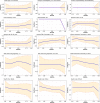Prevalence and risk predictors of childhood stunting in Bangladesh
- PMID: 36701381
- PMCID: PMC9879476
- DOI: 10.1371/journal.pone.0279901
Prevalence and risk predictors of childhood stunting in Bangladesh
Abstract
Background: The child nutritional status of a country is a potential indicator of socioeconomic development. Child malnutrition is still the leading cause of severe health and welfare problems across Bangladesh. The most prevalent form of child malnutrition, stunting, is a serious public health issue in many low and middle-income countries. This study aimed to investigate the heterogeneous effect of some child, maternal, household, and health-related predictors, along with the quantiles of the conditional distribution of Z-score for height-for-age (HAZ) of under five children in Bangladesh.
Methods and materials: In this study, a sample of 8,321 children under five years of age was studied from BDHS-2017-18. The chi-square test was mainly used to identify the significant predictors of the HAZ score and sequential quantile regression was used to estimate the heterogeneous effect of the significant predictors at different quantiles of the conditional HAZ distribution.
Results: The findings revealed that female children were significantly shorter than their male counterparts except at the 75th quantile. It was also discovered that children aged 7-47 months were disadvantaged, but children aged 48-59 months were advantaged in terms of height over children aged 6 months or younger. Moreover, children with a higher birth order had significantly lower HAZ scores than 1st birth order children. In addition, home delivery, the duration of breastfeeding, and the BCG vaccine and vitamin A received status were found to have varied significant negative associations with the HAZ score. As well, seven or fewer antenatal care visits was negatively associated with the HAZ score, but more than seven antenatal care visits was positively associated with the HAZ score. Additionally, children who lived in urban areas and whose mothers were over 18 years and either normal weight or overweight had a significant height advantage. Furthermore, parental secondary or higher education had a significant positive but varied effect across the conditional HAZ distribution, except for the mother's education, at the 50th quantile. Children from wealthier families were also around 0.30 standard deviations (SD) taller than those from the poorest families. Religion also had a significant relationship with the conditional HAZ distribution in favor of non-Muslim children.
Conclusions: To enhance children's nutritional levels, intervention measures should be designed considering the estimated heterogeneous effect of the risk factors. This would accelerate the progress towards achieving the targets of Sustainable Development Goals (SDGs) related to child and maternal health in Bangladesh by 2030.
Copyright: © 2023 Abdulla et al. This is an open access article distributed under the terms of the Creative Commons Attribution License, which permits unrestricted use, distribution, and reproduction in any medium, provided the original author and source are credited.
Conflict of interest statement
The authors have declared that no competing interests exist.
Figures
Similar articles
-
Determinants of stunting among children under 5 years in Bangladesh: a quantile regression analysis.J Hum Nutr Diet. 2025 Feb;38(1):e13383. doi: 10.1111/jhn.13383. Epub 2024 Oct 23. J Hum Nutr Diet. 2025. PMID: 39440486
-
Socioeconomic and demographic correlates of child nutritional status in Nepal: an investigation of heterogeneous effects using quantile regression.Global Health. 2022 Apr 20;18(1):42. doi: 10.1186/s12992-022-00834-4. Global Health. 2022. PMID: 35443701 Free PMC article.
-
Simultaneous quantile regression and determinants of under-five severe chronic malnutrition in Ghana.BMC Public Health. 2020 May 7;20(1):644. doi: 10.1186/s12889-020-08782-7. BMC Public Health. 2020. PMID: 32380990 Free PMC article.
-
Nutrition: basis for healthy children and mothers in Bangladesh.J Health Popul Nutr. 2008 Sep;26(3):325-39. doi: 10.3329/jhpn.v26i3.1899. J Health Popul Nutr. 2008. PMID: 18831228 Free PMC article. Review.
-
Nutritional interventions for preventing stunting in children (birth to 59 months) living in urban slums in low- and middle-income countries (LMIC).Cochrane Database Syst Rev. 2019 Jun 17;6(6):CD011695. doi: 10.1002/14651858.CD011695.pub2. Cochrane Database Syst Rev. 2019. PMID: 31204795 Free PMC article.
Cited by
-
Determinants of coexisting forms of undernutrition among under-five children: Evidence from the Bangladesh demographic and health surveys.Food Sci Nutr. 2023 Jun 9;11(9):5258-5269. doi: 10.1002/fsn3.3484. eCollection 2023 Sep. Food Sci Nutr. 2023. PMID: 37701232 Free PMC article.
-
Campylobacter colonization and undernutrition in infants in rural eastern Ethiopia - a longitudinal community-based birth cohort study.Front Public Health. 2025 Jan 7;12:1467462. doi: 10.3389/fpubh.2024.1467462. eCollection 2024. Front Public Health. 2025. PMID: 39839388 Free PMC article.
-
Malnutrition among under-5 children and its determinants in the southwestern coastal region of Bangladesh: A community-based study.BMJ Open. 2025 Jan 14;15(1):e090174. doi: 10.1136/bmjopen-2024-090174. BMJ Open. 2025. PMID: 39809564 Free PMC article.
-
Trends and long-term variation explaining nutritional determinants of child linear growth: analysis of Bangladesh Demographic and Health Surveys 1996-2018.Public Health Nutr. 2023 Dec;26(12):2758-2770. doi: 10.1017/S1368980023002288. Epub 2023 Oct 27. Public Health Nutr. 2023. PMID: 37886806 Free PMC article.
-
Identifying Individual and Household Level Predictors of Undernutrition Among 6-59 Months Children in Bangladesh: A Multivariate Approach.Public Health Chall. 2024 Oct 30;3(4):e70007. doi: 10.1002/puh2.70007. eCollection 2024 Dec. Public Health Chall. 2024. PMID: 40496425 Free PMC article.
References
-
- WHO. Stunting in a nutshell. In: Geneva: World Health Organization; [Internet]. 2015. [cited 12 Mar 2022]. Available: https://www.who.int/news/item/19-11-2015-stunting-in-a-nutshell.
-
- Eshete T, Kumera G, Bazezew Y, Marie T, Alemu S, Shiferaw K. The coexistence of maternal overweight or obesity and child stunting in low-income country: Further data analysis of the 2016 Ethiopia demographic health survey (EDHS). Sci African. 2020;9: e00524. doi: 10.1016/j.sciaf.2020.e00524 - DOI
-
- UNICEF, WHO, World Bank. Levels and trends in child malnutrition: Key findings of the 2020 Edition of the Joint Child Malnutrition Estimates. Geneva: WHO. 2020. Available: https://www.unicef.org/media/69816/file/Joint-malnutrition-estimates-202....
MeSH terms
LinkOut - more resources
Full Text Sources
Medical
Research Materials



